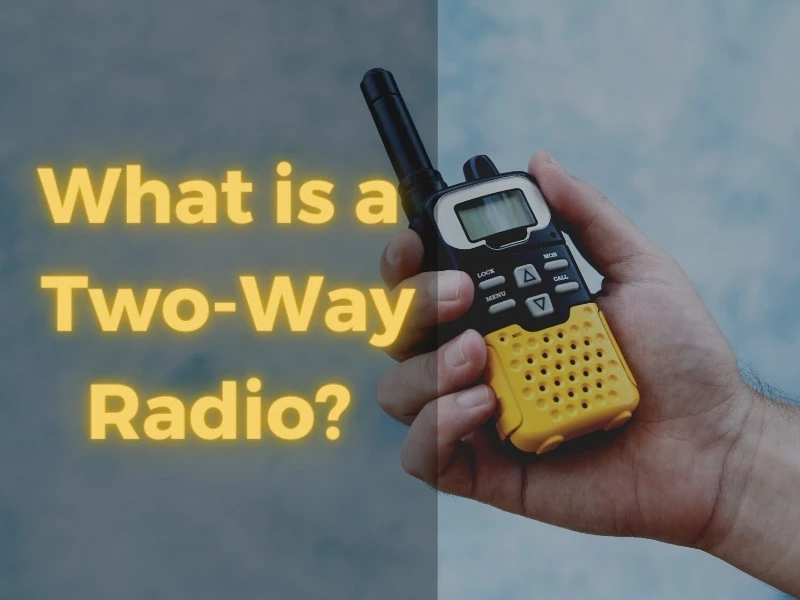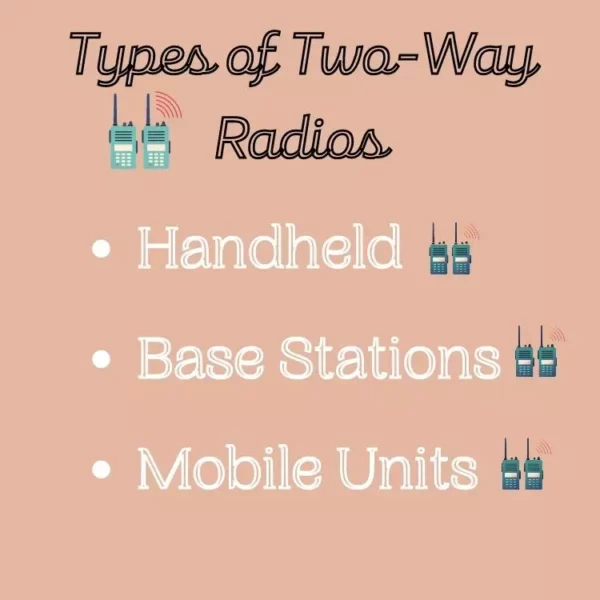
Radios can communicate over short or long distances and achieve this with their unique components.
Inside a radio, you will usually find a transmitter or broadcast receiver.
However, having one or the other means that users can only transmit or receive communication—not both. This is where two-way radios come in.
What is Two Way Radio?
A two-way radio is an audio transceiver with both a transmitter and broadcast receiver, meaning it can allow users to transmit and receive communications across radio waves. All the user must do is push down the device’s talk button to communicate to other radios on the same frequency.
Before the two-way radio was invented, many long-distance communications were only done through lighting and hand signals. But now, two-way radios have become a staple for law enforcement, the military, and hobbyists to communicate.
Topics Covered - Index
- What is Two Way Radio?
- How Does Two-Way Radios Work?
- Tips for Using Two-Way Radios
- Types of Two-Way Radios Available
- Other Variations of Two-Way Radios
- Conventional Two-way Radios vs. Trunked Two-Way Radios
- Simplex Channels vs. Duplex Channels
- Analog Two-way Radios vs. Digital Two-way Radios
- History of the Two-Way Radio
Also, Read
How Does Two-Way Radios Work?
Two-way radios work by converting audio transmissions to radio waves transmitted through the air. The receiving radio then converts the radio waves back to audio. There are two types of signals that two-way radios use for this process: one is an analog signal, and the other is a digital signal.
- Analog signals are more of the old-school version, where only audio is transmitted.
- Digital signals allow for many more types of transmissions, like text messages and other types of messages. Digital signals are also so advanced that some can be encrypted to prevent other people from using the network and seeing the communication without your permission.
Two-way radios also operate by using one of two different frequencies:
- UHF – Ultra-High Frequency
- VHF – Very-High Frequency
The most significant difference between the two is the length of their radio waves. A UHF wavelength tends to be shorter, which allows for easier communication inside a building or across a shorter distance. There are also more channels available on the UHF wavelength because they tend to be used within closer distances, and there is less of a chance of a competing radio source.
Meanwhile, the VHF wavelength allows for a greater broadcast distance if there are fewer impeding objects. For example, television stations covering a 60-mile radius might need to transmit 10,000 watts on a VHF wavelength, whereas a station on a UHF wavelength would need 3,000,000 watts. The VHF is excellent for usage outdoors, where the signal can travel great distances with no real interference.
Learn More about UHF vs. VHF Frequency.
Tips for Using Two-Way Radios
Most two-way radios will function best within short distances, but there are a few other tips to keep in mind to optimize your use of the device:
- Two-way radios that use the same frequency and channels will work best together. With that said, when purchasing a two-way radio, it is often recommended that you buy a second radio with the same capabilities.
- Your location will affect how well the two-way radio will work; for clear communications, make sure there’s a clear line of sight between you and the other radio operator.
- The higher in elevation you are, the more range you can achieve with a two-way radio.

Types of Two-Way Radios Available
Generally speaking, there are three categories of two-way radios:
- Handheld: Can be used daily by hobbyists, essential workers, and others who require portable communication
- Base Stations: Set up in a location with an antenna on the roof and used with a microphone
- Mobile Units: Can be attached to the dashboard of a vehicle, with a cord attached to the microphone, and plugged-in antenna
Within these categories, you have citizen-band (CB) radios and ham radios.
Other Variations of Two-Way Radios
The two-way radio has gone through some makeovers in the last 100+ years. Initially, the radios were very clunky and heavy. The receivers initially resembled those of a telephone as there were no “push-to-talk” buttons. As the invention went through changes, they became smaller and were more adaptable to their surroundings.
There are also several different variations of the two-way radio:
- Conventional vs. Trunked
- Simplex vs. Duplex Channels
- Analog vs. Digital
Conventional Two-way Radios vs. Trunked Two-Way Radios
In conventional radio, the radios operate on a fixed RF channel and can only run on one channel at a time. The users can communicate on a specific channel that both are on at the same time.
For example, a city might use a specific channel for local maintenance crews to communicate while using another channel specifically for a highway safety crew.
The trunked radio works similarly, with both users on a specific channel, but instead of the users choosing the channel, the radio itself will scan and choose the best channel to operate on. This system allows multiplexing, which is when multiple users are communicating on the same channel simultaneously.
Simplex Channels vs. Duplex Channels
Simplex channels are widely used for communication in a short distance with older systems. Two-way radios that operate on simplex channels can communicate on the same frequency, though users must take turns transmitting and receiving. Older maritime and commercial ships may still use simplex channels.
Duplex channels, on the other hand, are a bit more complicated because the system transmits and receives on different frequencies. They require a repeater, base station, or talk-through base to operate.
The advantage of this system is that it can be used across a wider-range of areas. But, the disadvantages are that you need a repeater or base station; plus, if one cannot reach the repeater, the system fails to work.
Nowadays, most two-way radios are on a half-duplex channel, meaning they operate like a duplex radio but have to switch between frequencies to transmit and receive communications. The most common example of this is the walkie-talkie, where the radio is always in a receiving mode, with the push-to-talk button creating the transmit part of the channel to make it duplex.
Analog Two-way Radios vs. Digital Two-way Radios
Analog systems are commonly used on the commercial side. Airlines and air traffic controllers using AM radio to communicate across airwaves is the most common example. The only issue with the analog system is that only one conversation can be had on the channel at a time.
Digital communication systems are most used with two-way radios. The best example would be cellphones, where conversations can happen across airwaves. The downside to this type of system is that the radios must all be designed the same way, with a lot of fluctuation in how they are designed. Also, these radios often cost more to make.
History of the Two-Way Radio
The two-way radio was perhaps one of the most important inventions of the 20th century. Before it was invented, there were minimal ways of communicating quickly across great distances. Since its creation, however, the progression of communication across cities, countries, and the globe has increased dramatically.
The two-way radio first emerged at the turn of the 20th century, with trans-Atlantic cables being strung across the Atlantic Ocean to connect the two sides of the world.
The earliest versions of two-way radios only allowed one communicator to transmit at one time; this was the “simplex” mode. It required a simple communication protocol for those operating the radios to communicate. However, with the later invention of receivers and transmitters, radios could now communicate across multiple channels, allowing for a freer communication link.
Today, two-way radios are used in various applications; besides what we know as “walkie-talkies” used among hobbyists, two-way radios are now used for transportation, emergency workers, gate call boxes, and more.
Best portable Ham Radios
Final Thoughts
Two-way radios have been around for more than 100 years and still continue to evolve with the times. Many different companies and industries rely on this technology to communicate with others, whether for emergencies, to provide direction, or even casual conversation. And because two-way radios have many applications, they’re always well worth the investment.
Citations: